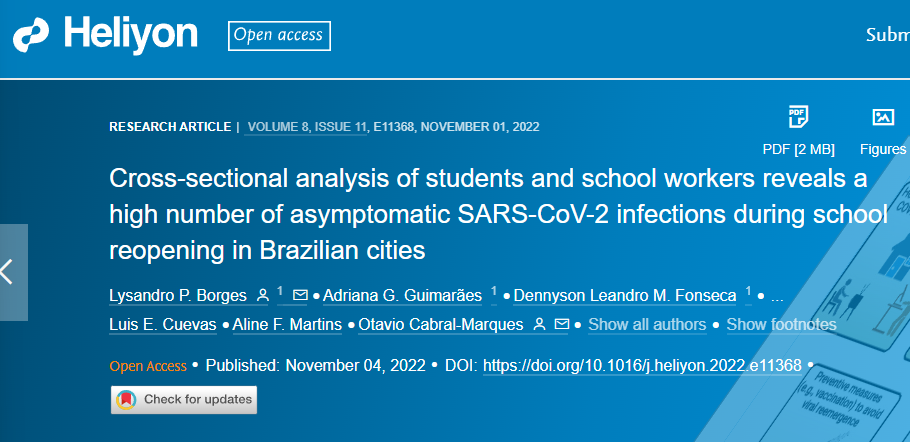Cross-sectional analysis of students and school workers reveals a high number of asymptomatic SARS-CoV-2 infections during school reopening in Brazilian cities
Brazil experienced one of the most prolonged periods of school closures, and reopening could have exposed students to high rates of SARS-CoV-2 infection. However, the infection status of students and school workers at the time of the reopening of schools located in Brazilian cities is unknown. Here we evaluated viral carriage by RT-PCR and seroprevalence of anti-SARS-CoV-2 antibodies (IgM and IgG) by immunochromatography in 2259 individuals (1139 students and 1120 school workers) from 28 schools in 28 Brazilian cities. We collected the samples within 30 days after public schools reopened and before the start of vaccination campaigns. Most students (n = 421) and school workers (n = 446) had active (qRT-PCR + IgM- IgG- or qRT-PCR + IgM + IgG-/+) SARS-CoV-2 infection. Regression analysis indicated a strong association between the infection status of students and school workers. Furthermore, while 45% (n = 515) of the students and 37% (n = 415) of the school workers were neither antigen nor antibody positive in laboratory tests, 16% of the participants (169 students and 193 school workers) were oligosymptomatic, including those reinfected. These individuals presented mild symptoms such as headache, sore throat, and cough. Notably, most of the individuals were asymptomatic (83.9%). These results indicate that many SARS-CoV-2 infections in Brazilian cities during school reopening were asymptomatic. Thus, our study highlights the need to promote a coordinated public health effort to guarantee a safe educational environment while avoiding exacerbating pre-existent social inequalities in Brazil, reducing social, mental, and economic losses for students, school workers, and their families.
Authors
Borges, Lysandro P; Guimari£es, Adriana G; Fonseca, Dennyson Leandro M; Freire, Paula P; Barreto, ikaro DC; Souza, Daniela RV; Gurgel, Ricardo Q; Lopes, Aline SA; de Rezende Neto, Jose Melquiades; Dos Santos, Kezia A;
External link
Publication Year
Publication Journal
Associeted Project
Digital Epidemiology
Lista de serviços
-
StructRNAfinder: an automated pipeline and web server for RNA families prediction.StructRNAfinder: an automated pipeline and web server for RNA families prediction.
-
CEMiTool: a Bioconductor package for performing comprehensive modular co-expression analyses.CEMiTool: a Bioconductor package for performing comprehensive modular co-expression analyses.
-
webCEMiTool: Co-expression Modular Analysis Made Easy.webCEMiTool: Co-expression Modular Analysis Made Easy.
-
Assessing the Impact of Sample Heterogeneity on Transcriptome Analysis of Human Diseases Using MDP Webtool.Assessing the Impact of Sample Heterogeneity on Transcriptome Analysis of Human Diseases Using MDP Webtool.
-
Predicting RNA Families in Nucleotide Sequences Using StructRNAfinder.Predicting RNA Families in Nucleotide Sequences Using StructRNAfinder.
-
OUTBREAK: a user-friendly georeferencing online tool for disease surveillance.OUTBREAK: a user-friendly georeferencing online tool for disease surveillance.
-
Noninvasive prenatal paternity determination using microhaplotypes: a pilot study.Noninvasive prenatal paternity determination using microhaplotypes: a pilot study.
-
Editorial: User-Friendly Tools Applied to Genetics or Systems Biology.Editorial: User-Friendly Tools Applied to Genetics or Systems Biology.
-
Automatic detection of the parasite Trypanosoma cruzi in blood smears using a machine learning approach applied to mobile phone imagesAutomatic detection of the parasite Trypanosoma cruzi in blood smears using a machine learning approach applied to mobile phone images
-
Tucuxi-BLAST: Enabling fast and accurate record linkage of large-scale health-related administrative databases through a DNA-encoded approachTucuxi-BLAST: Enabling fast and accurate record linkage of large-scale health-related administrative databases through a DNA-encoded approach
-
Ten quick tips for harnessing the power of ChatGPT in computational biologyTen quick tips for harnessing the power of ChatGPT in computational biology

